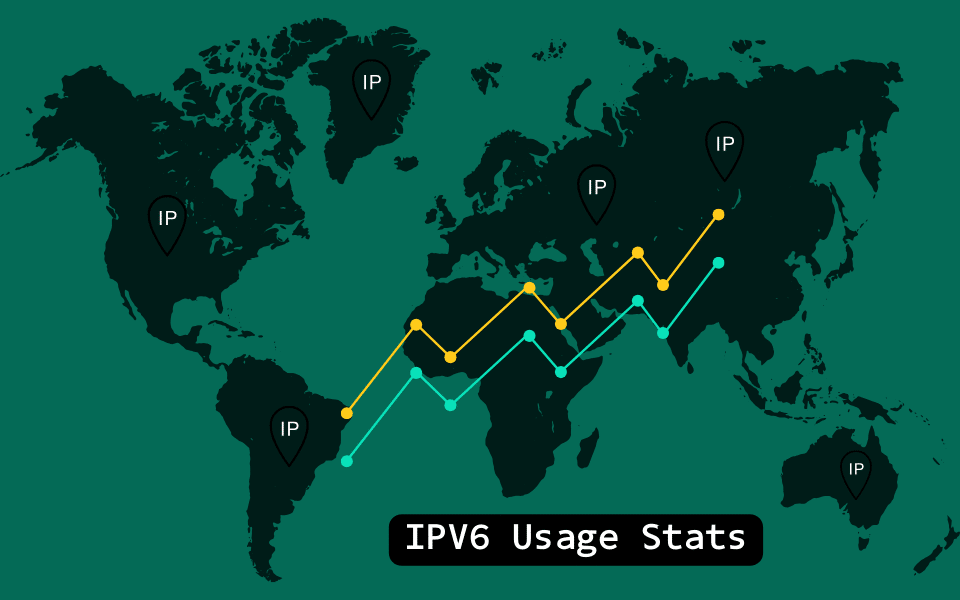Imagine the internet as a small town that’s grown into a huge city, fueled by the power of IPv4. But this expansion reached the bounds of IPv4, prompting the birth of IPv6 – a protocol designed for our digital future. Knowing this, IPV6 usage statistics and adoption trends intrigued us. So, we gathered the top stats related to IPV6 usage in 2024.
IPv6 isn’t just an answer to our address shortage, it is an upgrade with potential. The ability of IPv6 to assign an IP address for every grain of sand on the planet speaks volumes, underlining how it can drive our security and Internet of Things (IoT) growth.
In this article, we’ll look at global adoption rates, the journey of network providers, and the upcoming benefits and obstacles.
Table of Contents
- IPV6 Global Adoption Stats 2024
- How To Understand Global IPV6 Statistics?
- What Causes The Regional IPV6 Adoption Disparities?
- Historic IPv6 Adoption Statistics
- Mobile vs. Desktop IPV6 Usage Stats
- Network And Service Provider IPV6 Adoption Stats
- Endpoint of IPv6 Transition (Future outlook)
- What Drives The IPv6 Increasing Adoption?
- Real Time IPv6 Usage Stats Trackers
IPV6 Global Adoption Stats 2024
Global Adoption Rate:
In 2023, IPv6 adoption was between 45-50%. By 2024, this rate surpassed 50%.
Top Countries in Adoption:
- India: APNIC Labs reported more than 78% of India’s Internet traffic transiting via IPv6 by the end of April 2023.
- Germany: Following with 55.26%, a significant increase from 43.82% in 2019.
- United States: The adoption rate in the U.S. was approximately 50% in 2023.
Regional Variations:
- African countries like Nigeria, Morocco, Libya, Sudan show less than 1% readiness.
- Caribbean regions like Haiti and Cuba lag in adoption. The overall adoption rate in the Caribbean was reported to be up to 25%.
- Pakistan shows progress moving closer to a 5% adoption rate.

How To Understand Global IPV6 Statistics?
- Significance: The surpassing of the 50% adoption mark is a major milestone in IPv6 deployment, indicating a shift towards a more modern, scalable internet infrastructure.
- Impact on Future Internet Access: IPv6 offers vastly more IP addresses, crucial for accommodating the growing number of devices online. This expansion is essential for the future of IoT, smart cities, and emerging technologies.
What Causes The Regional IPV6 Adoption Disparities?
- Infrastructure: Regions with newer internet infrastructure have adopted IPv6 more rapidly.
- Policy and Regulation: Government policies promoting IPv6 can accelerate its adoption.
- Economic Factors: Wealthier regions may have more resources to invest in new technology.
- Awareness and Expertise: Knowledge about IPv6 and its benefits can influence adoption rates.
Historic IPv6 Adoption Statistics
- The depletion of the central IPv4 address pool managed by IANA in 2011 spurred increased attention to IPv6.
- The transition to IPv6 has seen accelerated momentum since 2016, with mobile networks in India and deployments in China contributing significantly to the growth.
Mobile vs. Desktop IPV6 Usage Stats
Mobile networks are significantly driving IPv6 adoption. In the US, for instance, 80% of smartphones on major cellular networks use IPv6. Mobile networks like Verizon Wireless, Sprint, T-Mobile USA, and AT&T Wireless show high percentages of IPv6 usage, with T-Mobile USA leading at 93%.
This is how mobile and desktop IPv6 compare:
- Mobile traffic is 50% more likely to use IPv6 compared to desktop traffic. Specifically, 21.4% of mobile traffic uses IPv6, while only 13.6% of desktop traffic is over IPv6.
- Among mobile operating systems, iOS sends slightly more IPv6 traffic than Android, with iOS accounting for about 23.5% and Android about 18.7%.
- For desktops, newer Windows operating systems send more IPv6 traffic, with Windows XP at 1.1% and Windows 10 at 18.7%.
- The type of browser and operating system significantly affects IPv6 traffic, with iOS and ChromeOS apps tending to use IPv6 more than other systems. Chrome on mobile sends about twice as much IPv6 traffic as Chrome on desktop.
This data indicates a clear trend towards greater IPv6 adoption on mobile platforms compared to desktops.
Network And Service Provider IPV6 Adoption Stats
IPv6 adoption is stalling in some areas due to high infrastructure costs and the need for network administrators to acquire new skills for managing the IPv6 address space. Here are some interesting stats about that:
- A survey of large content providers (such as Akamai, Google, Cloudflare, Facebook) in the first quarter of 2023 found IPv6 adoption rates of approximately 50% in the US, 33% in Canada, and up to 25% in the Caribbean economies
- The push for IPv6 support is ongoing, and more ISPs are enabling IPv6 access due to the exhaustion of IPv4 and the limitations of Network Address Translation.
- As of 2023, more than 40% of users worldwide accessed Google over IPv6, showing significant growth in IPv6 adoption compared to previous years.
- Detailed figures on the investment by major cloud providers like AWS and Microsoft Azure in IPv6 for 2023 are not available. However, it is known that these companies are continuously investing in and upgrading their infrastructure to support IPv6.
Endpoint of IPv6 Transition (Future outlook)
Defining the endpoint of the IPv6 transition is complex. It’s not a single, abrupt switch, but rather a gradual metamorphosis with stages and milestones. While completely eradicating IPv4 might seem like the ultimate goal, the reality is likely more nuanced.
Instead of a stark black-and-white picture, envision the endpoint as a spectrum. One extreme paints a world where IPv4 is entirely obsolete. At the other end, IPv4 might persist in pockets, serving niche applications or legacy systems.
Transition Endpoint likely Scenario
The more likely scenario lies somewhere in between. The tipping point could be when:
- IPv6 becomes the dominant protocol: Imagine a world where the majority of internet traffic, devices, and services seamlessly operate on IPv6. IPv4 may still exist, but its role would be akin to a vintage typewriter in a digital office – functional but increasingly irrelevant.
- IPv4 is no longer required for essential services: Access to critical online services like banking, healthcare, and emergency response should not be contingent on using a fading protocol. When all vital internet functions migrate to IPv6, the dependence on its predecessor significantly weakens.
- Cost-effectiveness of IPv4 dwindles: Maintaining aging IPv4 infrastructure becomes prohibitively expensive compared to the streamlined efficiency of IPv6. This economic pressure could naturally incentivize a complete shift.

What Drives The IPv6 Increasing Adoption?
The winds of change are blowing in favor of IPv6:
- Technological Advancements: Innovations like network virtualization and software-defined networking (SDN) are simplifying and accelerating IPv6 deployment.
- Government Initiatives: Policymakers worldwide are increasingly recognizing the importance of IPv6 and implementing initiatives to encourage its adoption.
- Growing Demand for Connectivity: The explosion of data-hungry devices and applications fuels the need for a more efficient and scalable internet infrastructure, which IPv6 readily provides.
Real Time IPv6 Usage Stats Trackers
Here are some of the leading real-time IPv6 usage trackers, along with key features of each:
1. Google IPv6 Statistics
- Data source: Google’s extensive global network.
- Features:
- Global IPv6 adoption rate.
- Country-specific adoption rates.
- IPv6 traffic trends over time.
- Interactive maps and charts.
2. Akamai IPv6 Observatory
- Data source: Akamai’s content delivery network (CDN).
- Features:
- IPv6 adoption insights across different regions, industries, and device types.
- Traffic analysis and performance metrics.
- Interactive visualizations and data exploration tools.
3. World IPv6 Launch Monitor
- Data source: Collaborative effort of multiple organizations.
- Features:
- Global and regional IPv6 adoption statistics.
- Tracking of IPv6-enabled websites and services.
- Data visualization tools for trend analysis.

4. Hurricane Electric IPv6 Statistics
- Data source: Hurricane Electric’s global network.
- Features:
- Real-time IPv6 adoption rates for countries and networks.
- IPv6 tunnel usage statistics.
- Historical data tracking for trend analysis.
5. APNIC IPv6 Deployment Monitor
- Data source: Asia-Pacific Network Information Centre (APNIC).
- Features:
- IPv6 adoption statistics for the Asia-Pacific region.
- Regional and country-specific trend analysis.
- IPv6 deployment case studies and best practices
6. RIPE NCC IPv6 Statistics
- Data source: Réseaux IP Européens Network Coordination Centre (RIPE NCC).
- Features:
- IPv6 adoption statistics for Europe, the Middle East, and Central Asia.
- IPv6 routing information and resource usage.
- Tools for network operators to track IPv6 deployment.
Reminder: These trackers provide valuable insights into the evolving landscape of IPv6 adoption. By regularly monitoring their data and visualizations, you can stay informed about the latest trends and make informed decisions about your own IPv6 deployment strategies.
Related posts:
- Tags:
- ipv6 proxies

